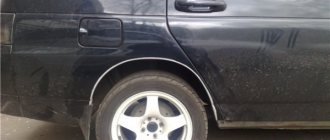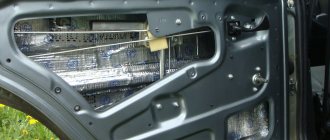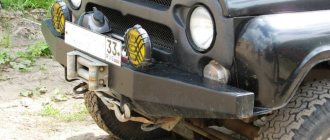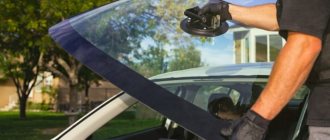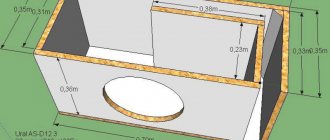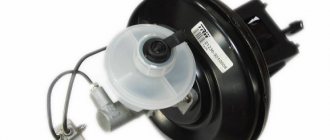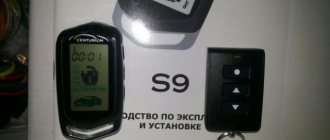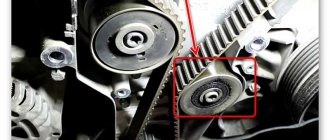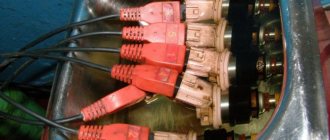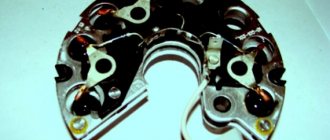Car sills are body elements that are subject to constant and maximum mechanical, vibration and temperature loads, and suffer from high humidity and corrosion. Awkward parking or a minor accident - and the threshold turns out to be jammed, which violates the geometry of the body and the external aesthetics of the car, interferes with the closing of the car doors and creates a threat of rapid corrosion of metal elements.
Therefore, repairing wrinkled thresholds is a common situation at service stations. How do car service professionals repair jammed door sills? Is it possible to level the threshold on a car yourself? How to do this, and what tool is needed for this?
How to bend a threshold on a car with your own hands
The threshold on a car is a kind of protection for the car and at the same time the most susceptible part to repair.
These parts suffer the most from external environmental influences: corrosion of metal by reagents, mechanical dents from gravel. Most often, the car begins to rot from the thresholds, so they are often treated with anti-corrosion agents and when painting the parts, they are treated with anti-gravel paint. Options for “how to extend a threshold on a car yourself at home” really exist and are practiced.
- Types of damage and types of car thresholds
- Repair of a separate threshold
- Cast threshold repair
- Common mistakes
How do professionals straighten thresholds?
In modern body repair, when straightening deformed sills, a spotter and various pulling devices are used (for more information about these devices, see the article “Spotter”). First, the protective coating is removed from the threshold to bare metal. Then, using a spotter, pulling elements are welded to the threshold, after which the dents are gradually pulled out and simultaneous tapping of protruding places and folds around the deformation, if necessary.
p, blockquote 4,0,0,0,0 —>
p, blockquote 5,0,0,0,0 —>
p, blockquote 6,0,1,0,0 —>
p, blockquote 7,0,0,0,0 —>
p, blockquote 8,0,0,0,0 —>
p, blockquote 9,0,0,0,0 —>
The pulling sequence is carried out depending on the structure of the damage. If the threshold flange (the lowest part where the threshold connects to the bottom) is damaged, then it must be returned to its place first. Next, you need to straighten the corners of the threshold if they are jammed. Thus, the main shape of the threshold needs to be restored first, and minor irregularities are corrected last. Shallow dents can be straightened with a reverse hammer, which is included with the spotter.
p, blockquote 10,0,0,0,0 —>
How to edit a threshold without painting
And we would immediately like to reformulate the title. It is important not only to understand how to straighten a threshold without painting, but also when it can be done safely and most effectively. The good news is that modern technology has come a long way: Paintless Dent Repair technology can effectively remove dents and damage in the following cases:
- Hail damage. In the case of thresholds, this rarely happens, due to their location, but repairs without painting also apply to other elements of the car. Pulling out an element using unique technologies is perhaps the best solution to the problem.
- Bad parking. This is the most common reason to resort to paintless dent repair. Hitting a high curb, colliding with an invisible obstacle - all this can cause damage to the thresholds.
- Mechanical damage while driving. The danger of this situation is that the car owner may not notice signs of damage for a long time. In this case, repairs without painting are not always possible due to damage to the paint layer.
Now let's talk about how to straighten a dent on a threshold without painting. The bad news is that you can hardly do this yourself: you need to have a whole arsenal of expensive tools and skills. Dent pulling is performed with original tools from the world's leading manufacturers. Typically, professional equipment from companies such as Nussle Spezialwerkzeuge, Stanliner, Dentcraft or Ultra Dent Tools is used. The technology itself requires difficult access or a special adhesive system from the outside.
The advantages of this approach are obvious:
- Preservation of original paintwork. This is not only about the fact that it is really difficult to choose the original tone and color of a car, but also about subsequent resale. It is impossible to repeat the exact tone - it can be made invisible to the naked eye, but with the appropriate technologies, repeated coloring is detected very quickly. Paintless technology avoids this.
- Repair speed. If the area and depth of the damage is small, then the speed of repair may pleasantly surprise you. Here's a simple example of how to fix a small dent. The classic method with welding, straightening and subsequent painting can take from several days to several weeks. Stretching takes from 5 minutes to 30.
- Low cost. Low cost is a subjective concept, but we are only comparing with other methods. Craftsmen do not need to remove parts; there is no need to purchase paints, varnish, or straightening compounds. All this reduces the cost of repairs, and the final cost of the work also decreases.
How to straighten a car threshold if you have a welding machine
Let's be honest, the methods described above for repairing thresholds without painting and without a welding machine are not always effective. If you need to eliminate a small dent or a very small area of corrosion, then these are really good methods. When we are dealing with a deep dent, damage to the paintwork, or serious rust, we have to solve the issue using a welding machine.
The main disadvantage of this method is the complexity of the work and the need to have your own equipment. We recommend that you do not skimp on repairs and contact professionals if you are not confident in your abilities or the correctness of the repair. Very often, car owners want to save money and limit themselves to leveling the sills and priming. In this case, the corrosion under the new layer of paint is not removed, and the body continues to deteriorate.
The process of repairing car thresholds with a welding machine can hardly be called a repair in the full sense of the word; it is, rather, a replacement. But this is the only option to completely eliminate the problem area on the car. With removable thresholds, it is increasingly easier to remove and perform any action: from replacement to cleaning. Fixed thresholds in combination with a welding machine and an angle grinder require the following set of actions:
- Raise the car as high as possible. The main task is to gain full access to the thresholds and ensure stability after cutting off the thresholds. Therefore, the point of support should not be chosen as thresholds. It is best to use a lift. Since we understand that we are talking about independent replacement, we can limit ourselves to a pit with bricks.
- Using a grinder we cut out the thresholds. Here you need to be very careful not to damage adjacent areas of the body. Doors and arches are at immediate risk. Therefore, carefully select the disc and constantly monitor the depth of the cut.
- Select a threshold of the exact size. You can try to eliminate corrosion on the old element. To do this, follow the advice from the previous paragraph. We thoroughly clean the area of corrosion and assess its depth. If most of the element is affected, we strongly recommend replacing the threshold.
- All that remains is to attach the threshold to the installation site and use welding. Try to make the seam neat and be sure to make longitudinal seams. After replacement, the threshold will lose up to 50% of its rigidity. To avoid body deformation, it is worth welding transverse reinforcements.
- At the final stage, all that remains is to straighten, prime and paint. Do not spare money on high-quality mixtures and paint, because this will determine the service life.
The procedure for replacing the threshold is not very simple, so you won’t want to repeat it. If you are not confident in your skills, we strongly recommend that you find a professional service center that can solve the problem with the warranty.
Leveling out dents on a removable threshold
Repairing damage to a removable threshold is much easier. For this type of work you will need:
- a workbench or flat base plate on which straightening will be done;
- set of tools for straightening. It includes all kinds of hammers (soft and hard), planes and chisels for straightening;
- grinder and welding machine or pneumatic chisel.
To level out a dent on a car's removable threshold, proceed as follows:
How to pull out a threshold with a reverse hammer
How to make sills on a car using a reverse hammer. Most often, a reverse hammer is used to get to a permanent part. To carry out leveling with a reverse hammer, you first need to clean the area that is to be restored.
After cleaning, it is necessary to dry and degrease the area, and also get rid of corrosion. Using a suction cup or applicator, the hammer must be attached to the center of the area being repaired. Using a weight, blows are applied to the hammer handle. You should start with light tapping, gradually increasing the force of the blow. Alignment begins from the edge of the dent.
Thus, the damaged area is straightened. When the outer side of the body takes on its previous appearance, the hammer can be disconnected.
Leveling with a reverse hammer is the most reliable method that protects against internal corrosion.
Car thresholds: basic repair methods
Today, there are two main methods for straightening car sills.
First way.
In the first method, a rectangular window is cut out into which the anvil is inserted.
This method allows you to tighten the affected area using hydraulic or mechanical devices.
Once the problem area has been corrected, the cut window can be carefully sealed. You can use tin solder to straighten the seam.
Second way.
In the second method, so-called transverse cuts are used, which are made in the surface of the threshold.
The weld points are separated, an anvil (preferably small) is inserted and the damaged area is straightened.
Welding is carried out only after straightening the surface. If the area directly under the door is damaged, it must be cut out and replaced with a similar one.
What to do if the dent on the threshold is too deep
The question is popular, but not entirely correct. The issue is what you call a dent that is too deep. If a crease has formed on the threshold, a section of the paintwork has worn off and there is a direct threat of corrosion, then the only correct solution will be a complete repair, including stripping, priming and painting. If we say that the dent is too deep to be pulled out without welding, then the only solution for a non-removable threshold will be a complete replacement with a welding machine.
If you are wondering what to do if the dent is too deep, then you are not entirely sure of your actions. You can look for a solution on the Internet, but where is the guarantee that you have correctly described the situation and are reading a reliable source. Therefore, for such problems, we recommend the following solutions:
- Find a service center. Finding a reliable service center is not so easy, it is much easier than a high-quality, proven article on the Internet. Just look at reviews or compare prices - after all, everyone has their own financial capabilities.
- Contact the administrator and tell them about the problem. You will probably still try to find information on the Internet. Call a service station representative and tell us about the problem. In 99% of cases they will tell you to come to the place, because... The technician needs to assess the extent of the damage. In most cases, this is free, but once again confirms the need for inspection by a professional; it will be too difficult for you to assess the damage yourself.
- After inspection, make a decision. You can act cunningly - listen to the opinion of the master and he will answer which solution, in his opinion, is optimal, visit several more centers and form an authoritative opinion, as in a survey. Then you can make a decision: if you are able to carry out the recommended procedures on your own, you can search the Internet for specific material. If not, we return to the center we like and enjoy the process.
The cost of the work will depend on many factors. The technician needs to assess the depth of the dent based on professional criteria. Depending on the degree of damage to the threshold, the optimal way to fix the problem will be chosen - this is called the complexity of the work. The cost also depends on consumables. If it is necessary to perform priming and painting, the cost of the work will be higher. Another important component of the price is the material of the threshold. Good luck on the roads!
Repairing car dents in auto repair shops
Nowadays, to eliminate such damage to the body, a device called a spotter, as well as other pulling devices, are used. In order to remove a dent on a car doorstep, the damaged area is cleaned from paint to metal. Next, using a spotter, several pulling elements are welded to the threshold. And at the end of the process, the dents are gradually drawn out, and, if required, the protruding places in the area of deformation are tapped.
The sequence of actions when pulling the threshold is determined by the type of damage. If the threshold flange is damaged, it is corrected first. This element is located at the very bottom of the threshold, at the junction with the bottom. The next step is to straighten the corners of the threshold if there are dents on them. From what is described above it is clear that first of all the threshold is returned to its original shape and only then the remaining irregularities are eliminated.
You can also pull out a dent on a car threshold using a welding machine:
- If you have a semi-automatic welding machine, but do not have a spotter, then a reverse hammer can also be used for straightening. You can make it yourself or buy it in a store.
- There is another way to straighten dents without using pulling devices. Its essence lies in the fact that the dent is cut with a cross (see the figure below) and each resulting segment is installed in place, for example, using a regular screwdriver. Then all the cut places are welded.
- You can also use a chain attached to the floor to straighten the threshold. Metal loops or plates with loops are welded to the place of deformation, which are connected by a chain to the floor (or other element) of the box, and the machine is lifted with a jack. During the lifting process, the dent is gradually straightened out. This method is good for eliminating deformation of the threshold flange, which is very rigid and difficult to straighten.
- If it is impossible to secure the chain to the lower elements of the box, then you should follow the same steps as in the previous paragraph, but insert a long lever (pipe or crowbar) into the chain.
One side of it should rest against a rigid part of the car’s underbody (spar), under which a block of the required thickness should be placed. The other gradually moves down. This way the lower part of the threshold is straightened. The side dent in the threshold can be straightened in the same way, but you need to find a side stop for the lever. For example, a block of the required length is passed under the machine, one side rests against the wall of the box, and the other side serves as a stop for the lever. - Since welding is used during the work, the inside of the threshold must be treated with an anti-corrosion agent. For these purposes, special technological holes are provided, closed with rubber plugs. As an option, you can use epoxy primer, which usually includes a tube with a nozzle that sprays 360 degrees. If you neglect this point, the metal will begin to rust from the inside.
- Treating the front part of the threshold with epoxy primer before puttying will provide increased protection against corrosion.
- Next, the threshold is puttied, leveled by sanding and primed with acrylic primer, and then prepared for painting and painted.
We recommend
“How to protect car sills: a few simple methods” Read more
Anti-corrosion treatment after repairing a dent on a car doorstep
Processing can be done in two ways.
The first involves the use of auto chemicals (mastic, special varnish or impregnation).
This method is best suited when the work is being done in a garage. But one of the disadvantages of such work is that it will require expensive materials.
Sometimes you can use cheaper materials, but they are not suitable for every foreign-made car.
The second method is electrochemical protection. It must be carried out in a car workshop, where all work is covered by a guarantee.
This protection is notable for the fact that special electrodes are installed on the threshold, to which direct current is supplied.
These elements, made of a more active metal, corrode first, and the body surfaces in contact with them (in particular, the thresholds) are restored. This protection is valid for one year. At low temperatures, the service life of the electrodes is reduced to 3 months.
There are services that install plastic threshold covers, the cost of which is low, and they are easy to change.
Such overlays perfectly protect the thresholds from dirt and stones, but not from corrosion, since it develops under them.
It is worth installing such an overlay only after the threshold has undergone anti-corrosion treatment.
Repair of removable thresholds
Most often, removable thresholds are made of metal (less often plastic). Fastening is carried out using self-tapping screws.
They are very easy to repair. It is necessary to carefully remove the product by unscrewing the screws and restore the threshold using a small hammer (if we are talking about a metal product).
After this, the threshold must be coated with a special anti-corrosion compound to prevent rust.
There are situations when repairing removable thresholds is useless (for example, when the material has already completely rotted).
It is better to completely replace the old threshold with a new one. This will end up being much cheaper.
Types of thresholds
Today there are two main types of thresholds - welded to the base or removable.
Removable thresholds are attached to the side and outside of the side members. Their main purpose is to protect the lower part of the car from small stones flying out from under the wheels.
Welded thresholds are more common. In fact, they blend into the underbody, giving it an extra level of rigidity.
How to repair it yourself without painting
Among all types of repairs, pulling out the threshold without painting is possible only in the case of slight deformation, without a sharp edge, when the paintwork is not damaged. A smooth dent without folds can be pulled out on its own in only two ways:
- using a pulling tool and hot glue;
- vacuum suction cups.
At service stations, a type of paintless body service using PDR technology is common. In this way, small, shallow deformations are eliminated. Craftsmen use special tools: levers and hammers, squeezing out a dent always occurs from the inside. When repairing a non-removable body element, it is necessary to use external tools; vacuum suction cups remain the best option. Considering that most defects are associated with damage to paintwork and metal cracks, the paintless method is not used when:
- The deformation of the metal has a sharp angle, and there is a crack in the protective coating.
- The first signs of corrosion appeared.
In case of such damage, it is necessary to carry out full surface treatment before and after reducing the dent.
How to pull out a threshold with a reverse hammer
Pulling out a threshold with a reverse hammer is considered one of the most popular and easiest ways to remove significant dents from a non-removable element. For repair you will need:
- grinding machine (grinder);
- reverse hammer;
- putty, hardener;
- sandpaper R-120, R-80;
- welding machine;
- automotive primer, degreaser;
What are the defects?
According to the nature of their origin, all defects are classified as natural, mechanical. In the first category:
- erasing the coating from corrosion, paint;
- the appearance of rust from exposure to external factors;
- metal wear.
Mechanical damage means:
- dents after hitting an obstacle, from impacts with gravel;
- factory defects in paintwork, lack of corrosion protection.
The repair procedure is selected depending on the degree of damage; if corrosion has covered more than 70%, the part is completely replaced. In case of deformation, if the metal does not require cutting, it is enough to straighten it. If the outer layer of anti-corrosion is damaged without damaging the outer and inner parts of the metal, then clean it and apply protection.
Typically, drivers have to repair a part after hitting an obstacle; you can straighten the threshold on a car with your own hands if there is no internal wear of the metal.
